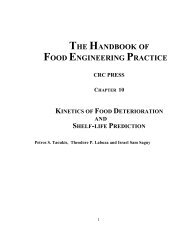Download - SMAS
Download - SMAS
Download - SMAS
- No tags were found...
You also want an ePaper? Increase the reach of your titles
YUMPU automatically turns print PDFs into web optimized ePapers that Google loves.
Fresh produce processors should consider these simple control measures (127) :1. Good quality raw materials from approved suppliers should be used2. Temperature control of fruit and vegetables should be implemented3. Environmental monitoring programme should be implemented4. Sanitation programme for warehouses and equipment should be implemented5. All fruit and vegetables should be washed and rinsed in potable water.Washing is a critical component in the preparation of fresh produce, especially if raw processedfresh produce is to be sold as a RTE food. Washing should always use potable water to (127) :1. Remove pieces of debris and dirt from produce2. Reduce microbiological and chemical loading of produce3. Reduce temperatures of produce to help enhance shelf-life.The FSAI recommends that the washing stage in fresh produce processing should consist of threeseparate washing stages and three separate tanks, all using potable water (i.e. recycled water shouldnot be used) (127) :1. A washing tank to eliminate general field debris and dirt2. A washing tank containing chlorinated water (50 - 100 ppm free chlorine with1 - 3 minutes contact time at a temperature between 8 - 10 o C and a pH of 6.6)3. A final stage washing tank using non-chlorinate potable water at 1 - 2 o C to remove chlorineresidues and enhance produce shelf-life.5.8 SeafoodEstuary and freshwater environments are often exposed to effluent discharges from municipalsanitary services, industry and agriculture which may be contaminated with L. monocytogenes.The salinity of estuary waters does not inhibit L. monocytogenes. Raw and processed fish are goodsubstrates for the growth of L. monocytogenes particularly if there is poor temperature control (129) .Control of post-harvest contamination of freshly caught fish is a vital step in producing safe RTEfish products (73) . All fish should be put on ice, refrigerated or frozen immediately following harvest.Typically, L. monocytogenes will not be found in fish harvested from open waters. However,contamination can occur prior to the fish reaching the processing facility. Sources of contaminationon fishing vessels include water, ice, human waste, birds (i.e. seagulls can be intestinal carriers of* Please refer to Reference 127 for further details.F O O D S A F E T Y A U T H O R I T Y O F I R E L A N D40














